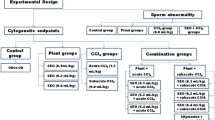Abstract
The aim of this study was to determine the chemical composition of Urtica dioica essential oil, and to evaluate its cytotoxic and genotoxic effects, using cytogenetic tests such as the cytokinesis-block micronucleus assay and chromosomal aberration analysis in human lymphocyte cultures in vitro. GC–MS analysis of U. dioica essential oil identified 43 compounds, representing 95.8% of the oil. GC and GC–MS analysis of the essential oil of U. dioica revealed that carvacrol (38.2%), carvone (9.0%), naphthalene (8.9%), (E)-anethol (4.7%), hexahydrofarnesyl acetone (3.0%), (E)-geranyl acetone (2.9%), (E)-β-ionone (2.8%) and phytol (2.7%) are the main components, comprising 72.2% of the oil. A significant correlation was found between the concentration of essential oil and the following: chromosomal aberrations, micronuclei frequency, apoptotic cells, necrotic cells, and binucleated cells.
Similar content being viewed by others
References
Aksu MI, Kaya M (2004) Effect of usage Urtica dioica L. on microbiological properties of sucuk, a Turkish dry-fermented sausage. Food Control 15(8):591–595
Azuma H, Toyota M, Asakawa Y, Kawano S (1996) Naphthalene—a constituent of Magnolia flowers. Phytochemistry 42(4):999–1004
Bakkali F, Averbeck S, Averbeck D, Waomar M (2008) Biological effects of essential oils—a review. Food Chem Toxicol 46(2):446–475
Bender ME, Huggett RJ (1989) Polynuclear aromatic hydrocarbon residues in shellfish. Species variations and apparent intraspecific differences. In: Kaiser HE (ed) Comparative aspects of tumor development. Kluwer, Dordrecht, pp 226–234
Cakilcioglu U, Turkoglu I (2010) An ethnobotanical survey of medicinal plants in Sivrice (Elazig-Turkey). J Ethnopharmacol 132(1):165–175
Chichester CH, Buckpitt AR, Chang A, Plopper CG (1994) Metabolism and cytotoxicity of naphthalene and its metabolites in isolated murine clara cells. Mol Pharmacol 45:664–672
Davis PH (1982) Flora of Turkey and the East Aegean Islands. Edinburgh University Press, Edinburgh, pp 633–635
Delgado-Rodriguez A, Ortiz-Marttelo R, Graf U, Villalobos-Pietrini R, Gomez-Arroyo S (1995) Genotoxic activity of environmentally important polycyclic aromatic hydrocarbons and their nitro derivatives in the wing spot test of Drosophila melanogaster. Mutat Res 341(4):235–247
Fenech M, Crott J, Turner J, Brown S (1999) Necrosis, apoptosis, cytostasis and DNA damage in human lymphocytes measured simultaneously within the cytokinesis-block micronucleus assay: description of the method and results for hydrogen peroxide. Mutagenesis 14(6):605–612
Gozum S, Tezel A, Koc M (2003) Complementary alternative treatments used by patients with cancer in eastern Turkey. Cancer Nurs 26:230–236
Graf U, Moraga AA, Castro R, Diazcarrillo E (1994) Genotoxicity testing of different types of beverages in the drosophila wing somatic mutation and recombination test. Food Chem Toxicol 32:423–430
Gulcin I, Kufrevioglu OI, Oktay M, Buyukokuroglu ME (2004) Antioxidant, antimicrobial, antiulcer and analgesic activities of nettle (Urtica dioica L.). J Ethnopharmacol 90(2–3):205–215
IARC (2002) IARC monographs on the evaluation of carcinogenic risks to humans. Some traditional herbal medicines, some mycotoxins, naphthalene and styrene. France, Lyon, 82:367–435
Ipek E, Tuylu BA, Zeytinoglu H (2003) Effects of carvacrol on sister chromatid exchanges in human lymphocyte cultures. Cytotechnology 43:145–148
Joulain D, Koenig WA (1998) The Atlas of spectra data of sesquiterpene hydrocarbons. Hamburg, EB-Verlag
Karabacak S, Bozkurt H (2008) Effects of Urtica dioica and Hibiscus sabdariffa on the quality and safety of sucuk (Turkish dry-fermented sausage). Meat Sci 78(3):288–296
Kokkini S, Karousou R, Lanaras T (1995) Essential oils of spearmint (carvone-rich) plants from the island of crete (greece). Biochem Syst Ecol 23:425–430
Konrad L, Muller HH (2000) Antiproliferative effect on human prostate cancer cells by a stinging nettle root (Urtica dioica) extract. Planta Med 66(1):44–47
Lazutka JR, Mierauskiene J, Slapsyte G, Dedonyte V (2001) Genotoxicity of dill (Anethum graveolens L.), peppermint (Mentha x piperita L.) and pine (Pinus sylvestris L.) essential oils in human lymphocytes and Drosophila melanogaster. Food Chem Toxicol 39:485–492
McLafferty FW, Stauffer DB (1989) The Wiley/NBS registry of mass spectral data. Wiley, New York
Patharakorn T, Arpornsuwan T, Wetprasit N, Promboon A, Ratanapo S (2010) Antibacterial activity and cytotoxicity of the leaf essential oil of Morus rotunbiloba Koidz. J Med Plants Res 4:837–843
Peres VF, Moura DJ, Sperotto ARM, Damasceno FC, Caramao EB, Zini CA, Saffi J (2009) Chemical composition and cytotoxic, mutagenic and genotoxic activities of the essential oil from Piper gaudichaudianum Kunth leaves. Food Chem Toxicol 47(9):2389–2395
Roncada T, Vicentini VEP, Mantovani MS (2004) Possible modulating actions of plant extracts on the chromosome breaking activity of MMC and Ara-C in human lymphocytes in vitro. Toxicol In Vitro 18(5):617–622
Saeed M, Higginbotham S, Gaikwad N, Chakravarti D, Rogan E, Cavalieri E (2009) Depurinating naphthalene-DNA adducts in mouse skin related to cancer initiation. Free Radical Bio Med 47(7):1075–1081
Sezik E, Yesilada E, Honda G, Takaishi Y, Takeda Y, Tanaka T (2001) Traditional medicine in Turkey X. Folk medicine in Central Anatolia. J Ethnopharmacol 75(2–3):95–115
Simpson CD, Cullen WR, Quinlan KB, Reimer KJ (1995) Methodology for the determination of priority pollutant polycyclic aromatic hydrocarbons in marine sediments. Chemosphere 31:4143–4155
Stammati A, Bonsi P, Zucco F, Moezelaar R, Alakomi HL, Von Wright A (1999) Toxicity of selected plant volatiles in microbial and mammalian short-term assays. Food Chem Toxicol 37(8):813–823
Wild SR, Waterhouse KS, McGrath SP, Jones KC (1990) Organic contaminants in an agricultural soil with a known history of sewage sludge amendments: polynuclear aromatic hydrocarbons. Environ Sci Technol 24:1706–1711
Author information
Authors and Affiliations
Corresponding author
Rights and permissions
About this article
Cite this article
Gül, S., Demirci, B., Başer, K.H.C. et al. Chemical Composition and In Vitro Cytotoxic, Genotoxic Effects of Essential Oil from Urtica dioica L.. Bull Environ Contam Toxicol 88, 666–671 (2012). https://doi.org/10.1007/s00128-012-0535-9
Received:
Accepted:
Published:
Issue Date:
DOI: https://doi.org/10.1007/s00128-012-0535-9




